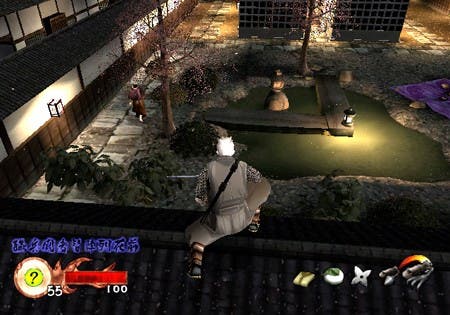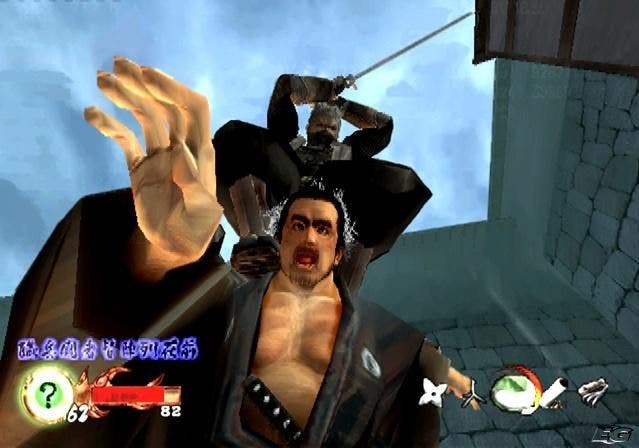Tenchu: Wrath of Heaven
Stealth kills, Rikimaru's return and a whole lot of ninja fun
When we first heard that Splinter Cell would theoretically let you travel from one end of the game to the other pausing only to kill the final boss, it seemed like the perfect embodiment of the games industry's newfound obsession with stealth. Sure enough, thanks to a mixture of delightful technical abilities and playfully constructed levels, with enough practise it is possible to avoid almost all confrontation.
But is that really fun? Games have made their mark on gamers for years with their obsessive compulsion to stab, shoot, maim, slaughter, disembowel and generally kick up a combative fuss. To suddenly be thrust into a world where the rules are almost entirely reversed left more of a "survival action" game than a stealth 'em up. All right for some, certainly, but to us even MGS2's song, dance and bloodshed punctuated stealthery held more allure. And when faced recently with kill-at-all-costs adventurer The Mark of Kri, its stealth kill moonlighting made a lot more sense than wandering around in the shadows hoping desperately not to be seen.
Funnily enough, this was around the time that K2's latest Tenchu adventure fell into our lap. And guess what? Stealth is of paramount import, but it works best as a precursor to action. This should be good.

Killing in the name of…
Instead of a Sam Fisher style solitary, invariable path, K2 offers the player three characters; Rikimaru, Tesshu and Ayame, with nine levels (roughly the same) for Rikimaru and Ayame and six for Tesshu. Each character starts out differently. In Rikimaru's case, K2 has him wake up from his ninja deep sleep, which explains away his supposed 'death' at the end of the first game. The veiled blonde swordsman sweeps along a beautiful mountain stream before leaping from a waterfall and taking up position at the start of the first mission. Ayame, on the other hand, has to complete a whole prologue section for her first mission, which gets her into the same temple compound as Rikimaru. Tesshu, meanwhile, simply spawns on the road alongside it.
Their text-based mission briefings with solemn voiceovers explain their varying motives for the level. Rikimaru and Tesshu are there to assassinate temple owner Echigoya, who it turns out has been collecting his debts by kidnapping village girls, exploiting them and then selling them onto slavery, and his pal Nasu, the government minister, who has been turning a blind eye.
Each level has three different 'layouts' to sample, and these affect guard positionings, allowing you to take on the same level three different ways - as each different character, if you like. The general goal of each is to navigate your way to the other end and assassinate someone or kick off a scripted event - like a meeting with Gohda, having cleared his home of enemy ninjas. You do this by utilising various stealth mechanisms - sidling along walls in familiar style, watching and waiting for patrolling guards to separate, then picking them off with stealth kill pounces from the rooftops, or relying on one of your inventory gadgets to find a vantage point (love that grappling hook…), piss them off (Shuriken) or, if they're facing away, to kill them outright with a blow dart.

Preview schmeview
Although this is still classed preview code, the control scheme and general feel of the game seem to be complete - and it's all very good and intuitive. A helpful Tutorial (which doesn't go hands-on, but shows you movies of the moves being explained) guides you through crucial techniques. At a fundamental level, everyone will get on with the 'left analogue movement, right analogue camera' system, and holding the R1 "stealth" button allows players to crouch and move along slowly, and less detectably, crawl through openings, lean up against walls and generally behave like a paranoid schizophrenic.
The other item of importance in general movement is the stealth meter in the bottom left of the screen. This little reading will count up from 0 to 100 demonstrating your exposure. With nothing on the scope you can move pretty freely, as no guards are patrolling nearby and nobody should be within glancing distance. 0-50 and you should keep an eye out for the guard, civilian or animal nearby, and anything higher and you should probably retreat and reassess the situation. Usefully, the number counts up and down gradually, so you can get an idea of a guard's movements from this. Generally speaking, if the threat level is decreasing, then he's walking away, and you've got the chance to cut him a new smile. Or embed a nail in his head. You know.
When seen, guards will yell "ninja!" in surprise and come after you - often stopping to pick up reinforcements. At this stage you have two options. The first of these is to engage the sorry stick or sword-wielding thugs with your own weaponry. In Rikimaru's case, a few choice 360 degree rotations plus square will scatter non-blocking foes, while R1 plus square will uppercut them into the air for a bit of juggling action. But for the most part, (and particularly for weaker combatant Ayame and the virtually unarmed Tesshu), the best option when spotted is simply to evade. Using the grapple hook on the Echigoya mission is the best method, getting you up on the roof, but beware that given a rooftop which can be scaled without the hook, guards will happily pursue you. Fortunately, they lose interest very quickly - "ah forget it!" they complain, as you stand ten feet behind them crouched on a higher rooftop, before returning to their patrols.

Silent justice
With the guards mostly oblivious to you, your efforts are immediately thrown into dispatching the most important ones (like those hiding the key to the temple gate, for example), and this is done by lining them up for stealth kills. Stealth kills are very organic - by holding R1 and pressing square around a clueless guard who hasn't spotted you, your character will perform some elegant but morally scandalous activity about their person with a sword, a knife or even bare hands. As long as the enemy doesn't know you're there, you can do this in most situations - holding R1/square on the way down from a rooftop pounce, from just round a corner, Mark of Kri style, from directly behind, and even from below in some cases. The animations and execution (both metaphysically and literally) are dazzling, and after you've done one or two you'll want to make stealth kills your primary means of progression.
Which is advisable, because another aspect of your HUD is nine faded Kanji symbols - and depending on the 'quality' of your stealth kill, your little Kanji bar will gradually illuminate. Once full, you get a little recital and then news of a new inherited ability, which is available to that character from thenceforth. For example, filling up Rikimaru on the first level earns a nice shoulder thrust to fatally round off juggle combos. Yet more incentive to kill precisely and cautiously.
However, it's not all free form roof hopping stealth slaughter, because sections of the first level and the entirety of others are given over to more traditional levels, with corridors, guarded rooms and so forth to traverse - you can do so with a certain degree of three dimensions - using the ceiling, rafters and so on - or simply use your stealth meter and free cam (L1) to keep an eye on guard movements before sidling up for a slash, but these do limit your creativity a bit. Hopefully there will be more variation in the final game.
True warriors unite!
Anyway, you can probably tell that we rather like the latest Tenchu. There's lots more to talk about of course, like the inventory system, the boss fights, the interior level design, the depths of the guard AI, the ranking system, the extensive replay value, the delightful two-player co-operative ninja mode, yadda yadda, but we'll save that for the review. The bottom line is that Wrath of Heaven has a lot of the heart and soul of more evasive stealthers, coupled with the elegance and ferocity of recent fave The Mark of Kri. The graphics engine is remarkably good, too, with huge, sprawling vistas in places - and the moonlit Japanese garden on the Echigoya stage is lovely, as are the snowy bamboo decked forests of Ayame's prologue and the gushing water outside Rikimaru's supposed tomb. It all looks very good for a PS2 title.
With the Wrath of Heaven due to fall next Friday, we'll be ploughing through the final version very soon and should have a review for you around then, but in the meantime it seems like good news for stealth fans everywhere, and a call to arms for those of us who found Splinter Cell's cerebral, hands-off approach to covert operations a bit too boring.
Tenchu: Wrath of Heaven screenshots (PS2)




.png?width=291&height=164&fit=crop&quality=80&format=jpg&auto=webp)



